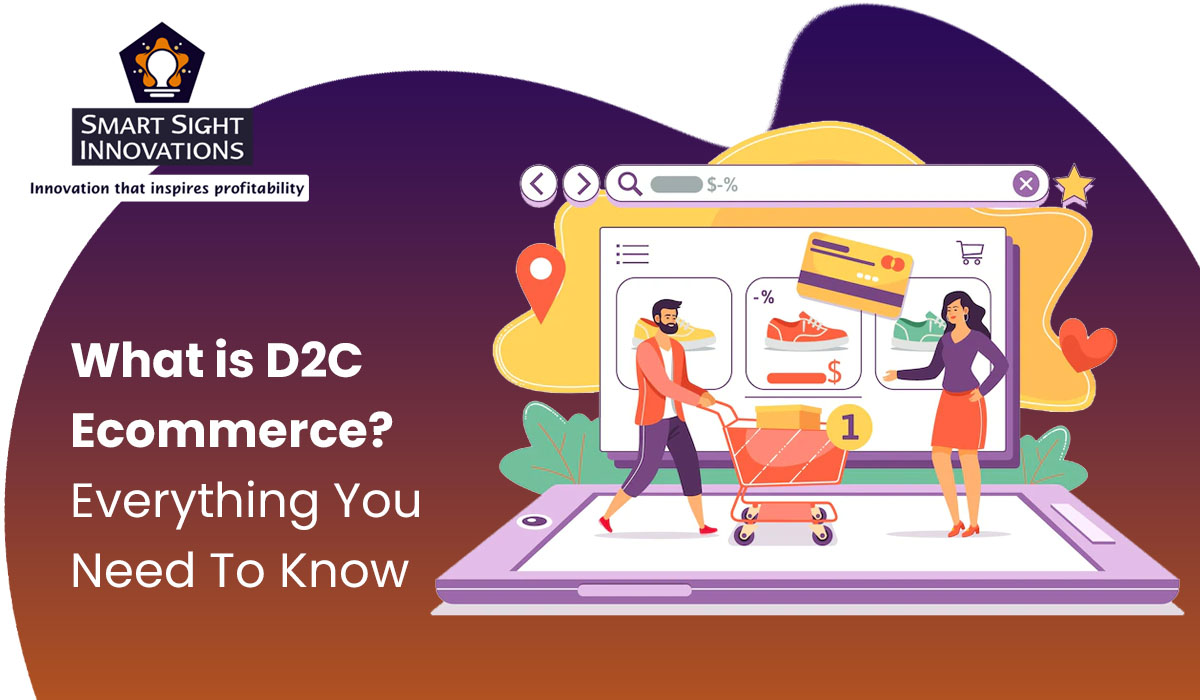Discovering the Prospective of D2C Ecommerce: A Comprehensive Guide for Companies
The D2C ecommerce model presents a considerable shift in just how brands engage with consumers. It makes it possible for firms to bypass typical retail channels, fostering deeper connections and potentially increased profit margins. However, this strategy is not without its complexities. Comprehending the subtleties of D2C ecommerce is essential for brand names aiming to prosper. What strategies can they adopt to navigate this evolving landscape effectively? The responses might redefine their service approaches.
Understanding the D2C Ecommerce Design

Trick Advantages of D2C Ecommerce for Brands
The D2C ecommerce model uses brands considerable benefits, specifically pertaining to raised revenue margins. By removing intermediaries, firms can maintain a larger share of sales revenue. Additionally, this straight relationship with consumers promotes boosted brand loyalty, motivating repeat acquisitions and long-lasting involvement.
Boosted Revenue Margins

Boosted Brand Loyalty
Structure on the financial benefits of D2C ecommerce, enhanced brand commitment arises as an additional essential benefit for companies involving straight with customers. By establishing a direct connection, brand names can promote much deeper relationships with their customers, gaining insights right into preferences and behaviors. This direct interaction enables even more personalized advertising and marketing methods, which resonate strongly with consumers. Furthermore, brand names have the chance to control their messaging and client experience, reinforcing brand worths and constructing trust. When customers really feel a personal connection, they are more most likely to return, support for the brand name, and take part in neighborhood engagement. Ultimately, improved brand commitment not just drives repeat acquisitions yet additionally cultivates an enthusiastic customer base, more solidifying a brand's position in the marketplace.
Challenges Encountered by D2C Brands
D2C brands come across several substantial difficulties that can influence their success. Inventory monitoring issues can bring about stock scarcities or excess, complicating procedures and consumer complete satisfaction. Additionally, advertising budget plan restraints frequently restrict the ability to properly engage and reach target market.
Stock Management Issues
Effective stock administration presents a powerful challenge for lots of brand names operating in the direct-to-consumer (D2C) space. These brands commonly face changing need, which can result in overstock or stockouts, eventually impacting customer complete satisfaction and income. Furthermore, the absence of sophisticated inventory monitoring systems can result in disparities in between actual supply levels and reported data, making complex order gratification. The varied variety of items D2C brands generally offer likewise makes complex supply management, as variants in dimensions, shades, and designs require more precise oversight. Numerous D2C businesses might battle with minimal warehousing abilities, leading to ineffective usage of space and sources. Reliable supply administration continues to be a vital difficulty for D2C brand names aiming for lasting growth and operational performance.
Advertising And Marketing Budget Plan Constraints
Maneuvering advertising and marketing budget restrictions is a considerable difficulty for several direct-to-consumer (D2C) brand names. Restricted monetary resources often limit these firms' capacity to spend in all-encompassing advertising techniques, leading to decreased visibility in an affordable market. D2C brands regularly face the demand to make best use of roi (ROI) while targeting particular audiences effectively. This challenge is intensified by rising costs in electronic marketing and the need to designate funds across multiple networks, consisting of social media, search engines, and email advertising and marketing. As a result, many D2C brand names have to introduce cost-efficient marketing options, leveraging organic growth techniques and influencer collaborations. Ultimately, effectively navigating these spending plan restrictions is necessary for maintaining development and achieving long-term earnings in the progressing ecommerce landscape.
Strategies for Developing an Effective D2C Ecommerce Company
As consumers increasingly seek direct connections with brand names, establishing an effective D2C ecommerce organization requires a critical method that prioritizes client involvement and depend on. One efficient method is to develop compelling brand name stories that resonate with target audiences, cultivating emotional links. Utilizing social media sites systems can enhance visibility and help with two-way communication, permitting brands to engage straight with customers.Moreover, individualized experiences via customized advertising and marketing initiatives can greatly enhance consumer retention and commitment. Executing loyalty programs and using unique deals can better incentivize repeat purchases.Streamlining the purchasing procedure is essential, ensuring a straightforward user interface that enhances the shopping experience. Additionally, transparent interaction concerning shipping and returns builds trust and urges consumer confidence.Finally, proactively looking for consumer comments and replying to it demonstrates a dedication to renovation and customer contentment, essential elements in the competitive D2C landscape.
Leveraging Modern Technology for Enhanced Customer Experience
In today's affordable D2C ecommerce landscape, innovation plays a pivotal duty fit client experiences. Companies increasingly make use of advanced devices such as expert system, chatbots, and customized algorithms to enhance communications and enhance the buying process. By incorporating these innovations, brand names can provide customized product suggestions based on specific preferences and purchasing behaviors, cultivating a more interesting experience.Moreover, responsive website styles and mobile applications guarantee that clients can access services seamlessly throughout different tools. Enhanced repayment services, consisting of electronic purses and one-click checkouts, additionally streamline transactions, making it less complicated for consumers to make purchases.Data analytics additionally makes it possible for companies to gather insights right into client actions, permitting for continuous renovation of offerings and services. On the whole, leveraging click resources technology not only enhances consumer contentment however additionally grows commitment, inevitably driving long-term success in the D2C ecommerce industry.
Marketing Techniques to Drive D2C Sales
How can brand names properly catch the focus of customers in a saturated market? To thrive in the direct-to-consumer (D2C) landscape, brands should utilize targeted advertising and marketing methods. Making use of social media systems, brand names can involve customers with interactive content, influencer collaborations, and user-generated articles. Personalized email campaigns can additionally promote a feeling of link, using customized promos based upon customer habits and preferences.Moreover, storytelling plays a crucial function in distinguishing a brand's narrative, making it remarkable and relatable. Brand names should buy seo (SEARCH ENGINE OPTIMIZATION) to boost exposure, ensuring their products are easily visible online. Additionally, leveraging information analytics permits services to improve their advertising and marketing strategies and understand customer trends better. Inevitably, a multi-channel technique that integrates creativity with data-driven understandings can substantially increase D2C sales, allowing brand names to stand out in a crowded marketplace.
Future Patterns in D2C Ecommerce
With the rapid advancement of innovation and consumer choices, the future of D2C ecommerce is positioned for considerable transformation. Arising trends indicate a shift towards hyper-personalization, where brands leverage data analytics to customize offerings to individual customer requirements. This modification boosts client experiences, fostering commitment and engagement.Moreover, sustainability is coming to be an important element, with customers significantly preferring brands that prioritize environmentally friendly practices - D2C Ecommerce Agency. Firms are expected to embrace transparent supply chains and lasting products to fulfill this demand.The integration of man-made intelligence and boosted fact will in addition reinvent the purchasing experience, allowing consumers to visualize items in their environments prior to purchase. On top of that, social business is prepared for to expand, as systems like Instagram and TikTok facilitate seamless shopping experiences directly within social media.These trends jointly signify a vibrant future for D2C ecommerce, stressing customer-centric methods and ingenious innovations that redefine customer interactions
Regularly Asked Concerns
What Industries Benefit Most From D2C Ecommerce?
The existing question highlights industries that grow through direct-to-consumer (D2C) ecommerce. Extremely, style, appeal, electronic devices, and food markets take advantage of D2C versions to boost brand name commitment, enhance client relationships, and maximize earnings margins properly.
Just How Do Shipping Costs Influence D2C Pricing Techniques?
Shipping prices significantly influence D2C rates methods. Organizations should stabilize these expenditures with affordable prices, taking into consideration consumer expectations and revenue margins. Reliable management of delivery can boost consumer contentment article source and drive sales in direct-to-consumer designs.
What Payment Alternatives Should D2C Services Offer?
D2C organizations must provide diverse repayment choices, including credit/debit cards, digital wallets, and purchase now, pay later solutions. This variety boosts consumer benefit, boosts conversion prices, and satisfies different consumer preferences in the online buying landscape.
How Can D2C Brands Deal With Client Returns Efficiently?
D2C brands can handle client returns successfully by carrying out user-friendly return policies, providing prepaid delivery labels, and ensuring timely reimbursements (D2C Ecommerce Agency). Clear interaction and streamlined processes improve client complete satisfaction and encourage repeat organization
What Lawful Factors To Consider Exist for D2C Ecommerce Operations?
Legal considerations for D2C ecommerce procedures include compliance with consumer protection legislations, information privacy laws, intellectual home rights, and tax demands. Brands must navigate these complexities to stay clear of lawful risks and assure smooth procedures. By removing intermediaries, D2C brands can supply affordable pricing and foster a more intimate relationship with their customers.The D2C design is characterized by its reliance on digital platforms, allowing brands to use social media, on the internet markets, and their he has a good point own websites to involve with consumers straight. D2C ecommerce promotes the collection of important consumer data, allowing brand names to tailor their offerings and marketing strategies properly, inevitably driving sales and boosting margins. In addition, brand names have the possibility to manage their messaging and client experience, enhancing brand name worths and building trust. As consumers significantly look for straight links with brands, developing a successful D2C ecommerce company requires a tactical technique that focuses on client interaction and count on. D2C brand names can manage customer returns properly by carrying out easy to use return plans, offering pre-paid shipping tags, and guaranteeing punctual refunds.